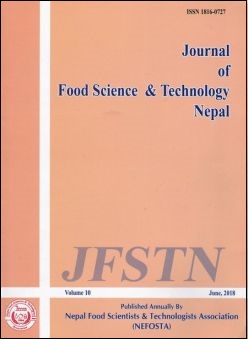Evaluation of Modified Sorghum Starches and Biodegradable Films
DOI:
https://doi.org/10.3126/jfstn.v10i0.14800Abstract
The properties of bio-films prepared from sorghum starch using three different modification techniques (hydrothermal treatment (HTT), acid-alcohol treatment (AA) and acetylation (A)) were studied. The physical properties of modified starches were significantly different from unmodified starches. More specifically, acetylated starch had significantly higher swelling power and solubility, where-as HHT starch had the highest water binding capacity. Starch films prepared from hydrothermal treatment had the least solubility (26.15%) and the maximum tensile strength (TS) - (6.50MPa), whereas films prepared from acid-alcohol treated starch had the lowest water vapour transmission rate (WVTR) (720.0 g/m2/d) and acetylated starch film had the maximum elongation (19.03%). The concentration of glycerol, a plasticising agent, affected the properties. The WVTR of the films increased with an increase in glycerol concentration; while tensile force and elongation decreased.
Downloads
2343
773
Downloads
Published
How to Cite
Issue
Section
License
The author will be the copyright holder of this open access journal - 'Journal of Food Science and Technology Nepal (JFSTN)'.




